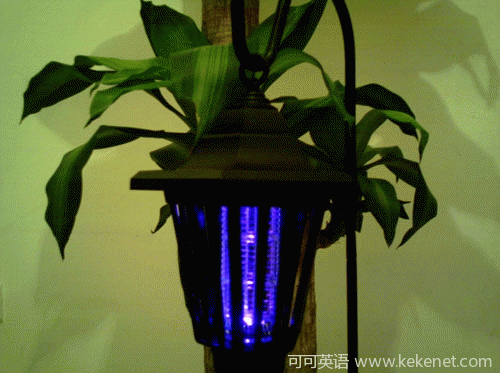
Science and Technolgy.
科技。
Photoelectric cells.
光電池。
To dye for.
染料光電池。
A new type of cell may bring "solar" energy indoors.
一種新型電池有望將"太陽能"引進(jìn)室內(nèi)。
THE phrase "indoor solar power" sounds like an oxymoron. But there is growing interest in the idea of using photoelectric cells to run gadgets as well as power grids-and doing so even when those gadgets are inside buildings. Much of the light these cells used would, of necessity, come from incandescent bulbs, fluorescent tubes and light-emitting diodes (LEDs) rather than through the window from the sun. But if the right sorts of cells were available this could be cheaper than constantly replacing the batteries that currently power electronic gizmos.
"室內(nèi)太陽能"這詞聽著像個(gè)冤親詞。但是人們卻對(duì)利用光電池為電子產(chǎn)品及電網(wǎng)供電(即便電子產(chǎn)品位于室內(nèi))這個(gè)想法興趣漸濃。當(dāng)然,這種電池所用的光大部分來自白熾燈、熒光燈及LED燈,而非透過窗戶照進(jìn)來的陽光。若有適合的光電池能替代目前電子產(chǎn)品所用的要經(jīng)常更換的電池,那用電成本將會(huì)降低。
On April 8th G24 Innovations, a firm based in Wales, announced that it may have come up with just such a cell. The latest version of its special, dye-based photoelectric devices has set a new record for the conversion of light from bulbs into electricity: an efficiency of 26%, compared with the 15% which previous ones can manage. That lifts dye-based cells to the point where they might be widely deployable for indoor power.
4月8日,總部位于威爾士的G24創(chuàng)新公司宣布他們可能已經(jīng)發(fā)明出這種電池:公司最新的特制染料光電器件已創(chuàng)下白熾燈光轉(zhuǎn)換為電能的效率新記錄:26%,而以前的器件轉(zhuǎn)換效率僅為15%。這使染料電池有望廣泛應(yīng)用至室內(nèi)發(fā)電中。
Dye-based cells are similar to the silicon-based variety found on rooftops around the world in that both rely on a semiconductor to assist the conversion of luminous energy into the electrical sort. The difference is that in the case of silicon cells, this conversion happens directly. That means the frequency of light absorbed is constrained by the physical properties of silicon itself.
染料電池類似于安裝在世界各地屋頂上的硅光電池,兩者都靠半導(dǎo)體器件將光能轉(zhuǎn)換為電能。它們的區(qū)別在于,硅光電池是直接將光能轉(zhuǎn)換為電能的,即受硅的物理性質(zhì)限制,它只能吸收特定頻率的光。
In the case of dye-based cells, which were invented at the Federal Polytechnic School of Lausanne, in Switzerland, in the 1990s, the light is first captured by molecules of a photosensitive dye. Tinker with the composition of this dye and you change the frequency of light that can be captured. This makes dye-based cells more flexible than silicon ones.
而在染料電池中,光會(huì)先被光敏染料的分子捕獲。染料電池是在上世紀(jì)90年代由瑞士洛桑聯(lián)邦理工學(xué)院發(fā)明的。稍微改變一下這種染料的成分,就可以讓它吸收另一種頻率的光。這個(gè)特性使染料電池比硅光電池更加靈活。
The dye molecules themselves are bound to tiny particles of titanium dioxide, a less-famous (but cheaper) semiconductor than silicon, and the whole assembly is immersed in an electrolyte and sandwiched between two electrodes. When a photon of light is absorbed by a dye molecule, an electron is knocked into the titanium dioxide. From there it travels to one of the electrodes and a current is thus generated.
光敏染料分子本身附著在二氧化鈦微粒上,二氧化鈦是種半導(dǎo)體,沒有硅那么廣為人知(但更便宜)。整個(gè)附著過程都是在電解液里兩個(gè)電極之間進(jìn)行的。當(dāng)一個(gè)染料分子吸收一個(gè)光子時(shí),一個(gè)電子就會(huì)受到碰撞,進(jìn)入二氧化鈦中。電子從那里向其中一個(gè)電極運(yùn)動(dòng),由此產(chǎn)生電流。
The flexibility brought by the dye-based approach makes this sort of cell particularly useful indoors. Silicon-based solar cells have been optimised for sunlight. But artificial light, whether of the incandescent, fluorescent or LED variety, contains a different mixture of frequencies from that put out by the sun. By changing the composition of the dye, G24's engineers ensure that the maximum sensitivity of the cell coincides with whatever frequency mix is appropriate for the artificial light concerned.
染料電池的這種靈活性讓其特別適用于室內(nèi),硅光電池則已被優(yōu)化至最有利于吸收陽光。但人造光(不論是白熾燈、熒光燈還是LED燈的光)的光譜都和陽光的不同。通過改變所用染料的成分,G24的工程師保證了光電池的最大感光度與特定場合使用的適當(dāng)?shù)娜嗽旃庠吹墓庾V相吻合。
Besides being tweakable to match the spectrum of a light-bulb, dye-based cells also work well in dim or diffuse light of the sort often found indoors. Silicon-based systems do not. And dye-based cells, having no rigid parts, can bend, and are mechanically robust compared with the silicon sort. That gives them a further advantage over silicon cells, especially for powering consumer gadgets.
除了能夠稍作調(diào)整以適應(yīng)燈泡的光譜外,染料電池還能在昏暗的環(huán)境或漫反射光照射下(常見于室內(nèi))正常工作,硅光電池則不然。而且染料電池沒有剛性部件,可彎曲,與硅電池相比更為結(jié)實(shí)耐用。這讓它們比硅光電池又多了一項(xiàng)優(yōu)勢,尤其是在為消費(fèi)電子產(chǎn)品供電方面。
Steven Burt, G24's chief financial officer, talks of light-bulb-powered TV remote controls, smoke detectors and computer keyboards. (A non-removable internal battery would store charge for use when the lights are off.) The company already offers prototypes of bags and jackets with photosensitive panels woven in, designed to charge digital cameras and mobile phones, and a hotel in Las Vegas is using G24's products to run its electric window-blinds. Mr Burt also sees a market for powering the networks of sensors needed to monitor things like temperature and humidity in modern "smart" buildings.
G24的財(cái)務(wù)總監(jiān)史蒂芬?伯特(Steven Burt)談到了用燈泡供電的電視遙控器、煙霧探測器和電腦鍵盤。(內(nèi)置一個(gè)固定電池儲(chǔ)存電能以在關(guān)燈后供電。)該公司已推出內(nèi)部裝有光敏電池板的夾克和背包樣品,用來為數(shù)碼相機(jī)和手機(jī)充電。現(xiàn)在,拉斯維加斯的一家酒店使用了G24的產(chǎn)品來為其電動(dòng)百葉窗供電。史蒂芬?伯特還認(rèn)為染料電池在為現(xiàn)代"智能"建筑中的傳感器網(wǎng)絡(luò)(用于監(jiān)測溫度、濕度等)供電方面很有市場。
Eventually, says Mr Burt, the ability of dye-based cells to produce useful quantities of power even in dim and diffuse light could see them used outside, perhaps on rooftops in cloudier parts of the world-a market at present dominated by traditional, silicon-based cells, even though they are not well-suited to the purpose. But for now, G24's factory in Cardiff, not a city known for its sunshine, remains powered by a wind turbine.
史蒂芬?伯特說,在昏暗或漫反射光環(huán)境里染料電池也能產(chǎn)生足夠的電量,最終這種性能會(huì)讓它們能夠應(yīng)用于室外,可能是裝在云層較厚的地區(qū)的屋頂上。這個(gè)市場目前是由傳統(tǒng)的硅光電池主導(dǎo),雖然它們并不適合在昏暗環(huán)境下工作。只不過,G24公司位于加的夫這個(gè)日照不多的城市的工廠如今卻仍然依靠風(fēng)力渦輪機(jī)發(fā)電。











